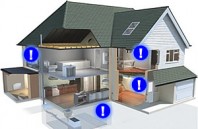Location of a Carbon Monoxide (CO) detector can save a life!

CO detectors should be replaced per the manufacturer’s recommendations or every 5 years, whichever comes first.
It’s that time of year, when our heating systems and fireplaces have been getting a pretty good work out. And it’s all the more reason to be ever vigilant for the silent killer – Carbon Monoxide (CO)! It’s the odorless, tasteless and invisible by-product of combustion that poisons hundreds of people each year.
That said, installation of carbon monoxide detectors and their placement are very important. First and foremost, all of the manufacturer’s instructions and those of the Building and Fire Code established by the state and/or municipality within which you reside should be followed.
To summarize, here are a few guidelines to follow when installing a CO detector:
- A CO alarm should be placed on every level in the home where a CO source exists, such as cooking appliances, fireplaces or other fossil fuel burning appliances.
- A CO alarm should not be placed within 15 feet of fossil fuel burning appliances.
- A CO alarm should be placed within 15 feet of a sleeping area. No sleeping area or unit should be more than 15 feet away from a CO alarm or detector. In other words, you may need to install more than 1 CO alarm on a floor level to ensure proper coverage for each sleeping area.
- A CO alarm should be placed in the living area directly above an attached garage.
- A CO alarm should be placed in the hallway leading to an attached garage.
- Follow the manufacturer’s directions for placement, keeping in mind installation high on a wall or ceiling area is often an ideal placement location. Try to keep at least 5-10 feet away from kitchen appliances and bathrooms.
- In New York State, for homes constructed after 1/1/2008 each sleeping unit should have a CO alarm.
- They should be hardwired (not the plug-in style) to the home’s electrical source with a battery back-up.
- They should be interconnected so that when 1 alarm sounds, they all sound.


